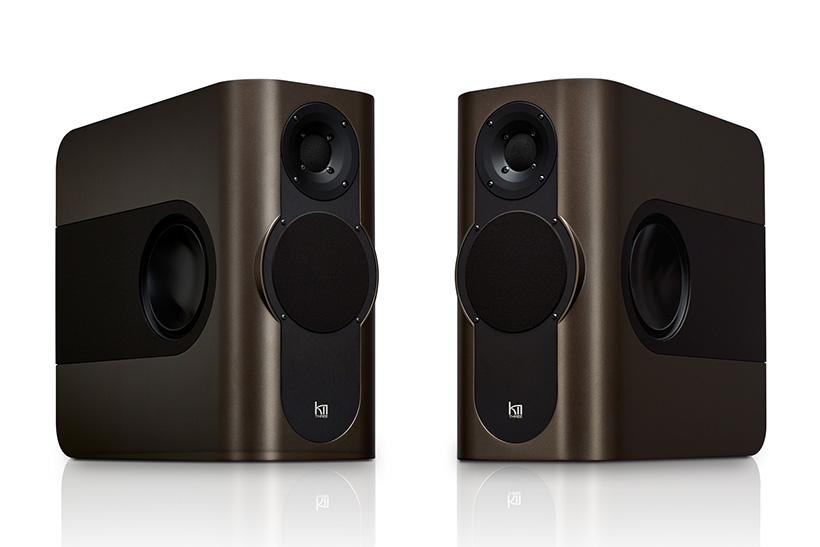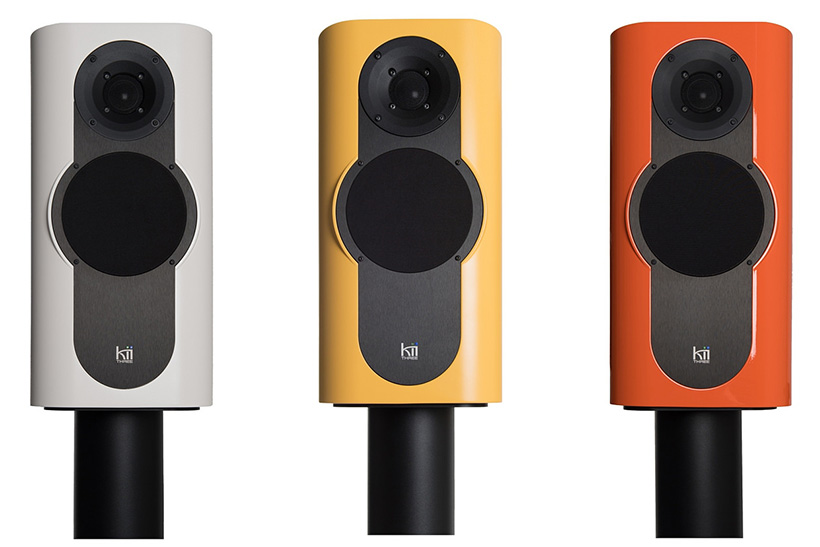Most loudspeaker makers improve their products by degrees; they refine cabinets, drive units and crossovers and gradually make them better. You get the occasional jump in performance when a new cone or dome technology is developed but on the whole it’s an incremental process. Newcomer Kii Audio takes a rather different approach. Rather than using existing technology to create a loudspeaker that’s a little bit different from the rest, they have ignored the way in which most designers have tackled the challenges and come up with a ground up design that is dramatically different in design and sound.
One of the team behind Kii Three is class D amplifier guru Bruno Putzeys, whose long list of design credits includes UCD circuitry for Philips, NCore for Hypex, Grimm Audio active DSP loudspeakers and Mola Mola amplifiers. Together with Chris Reichardt from pro audio and software specialist Bart van der Laan, Bruno has developed the Three for domestic and pro environments using specially designed N-Core amplifiers, DSP amplification and a multi-driver array in a compact standmount cabinet. The Kii Three stands 40cm high yet contains four bass drivers, a midrange and a tweeter. And they’re not small drivers: the bass units are specified as six and a half inch (165mm) devices. There are drivers on every surface except top and bottom but it’s the two on the back that are the biggest clue to the radical thinking behind the design.

It’s long been understood that a major influence on the sound of any speaker is beyond the control of its designers. They cannot predict what your room will do to output frequencies, especially bass. Every room has low frequency suck outs and reinforcements that have a clear effect on the sound of the speaker and the lower the bass frequency, the greater the effect. Most companies recommend that you move the speaker closer or further from the wall to neutralise the problem but this is only ever a partial solution.
Putzeys and his team decided to tackle this issue head on by developing a speaker that cancelled out the bass that comes from the rear and sides of any loudspeaker regardless of driver configuration. They created what they call ‘Active Wave Focusing’, which essentially means that the bass only comes from the front of the loudspeaker and so is not reinforced by room boundaries. This is achieved with a cardioid-shaped wave form and is the first instance of this approach I have encountered. Kii also included equalisation so that other frequencies could be adjusted for situations where mid and high frequency reflections are a problem. By using powerful DSP they also claim to achieve a frequency response that’s within plus or minus half a decibel from 30Hz to 20kHz – something that no other speaker manufacturer would dare declare for real world conditions. The manual even suggests that the Kii Three can be placed as close as three inches (75mm) from a rear wall.

Guru Putzeys
Kii Audio are, unsurprisingly perhaps, vague about a lot of the detail in the design of this speaker. They won’t divulge what the drive units are made of (they look like aluminium, albeit the grilles are hard to see through), nor will they say what the sealed cabinet is made of. The details that are available include the presence of six 250 Watt custom NCore amplifiers, six channels of DSP and the digital to analogue conversion to go with them.
The Kii Three is not even conventional in the way it is connected to a system. As there are DACs onboard it accepts a digital signal but only via ethernet cable from the Kii Controller (or via AES/EBU. You can make a single analogue connection to each speaker from an analogue preamp via XLR, but for optimal operation and practicality Kii recommends the Kii Controller, which has inputs for digital sources via USB, SPDIF coax and Toslink optical, operates as a volume control (for analogue sources as well) and offers speaker set up via its small OLED display. The Controller connects to one speaker via ethernet cable and the signal is sent on to the second speaker using a similar RJ45 terminated cable. This means just one slim cable from controller to speaker. The Controller is so small that if you have a long digital cable (and/or a nearby source) it’s possible to put it on the couch beside you. That said it is remote controllable with any RC5 or Apple handset, the distributor supplied the latter, which is a very cute device.

Sound quality
I was warned that the Kii Three would take some getting used to and it certainly did. When you take the room reinforcement out of the equation you get a very different sound. I used these speakers with the Innuos Zenith SE server and Auralic Aries G2 streamer, connecting the USB output of the latter to the Controller. The result was incredibly clean, detailed and even in the bass, with unusual extension given the box size. The effect is extraordinarily revealing, I heard new detail in tracks that I’ve been listening to for years. Sometimes it could sound a bit lean; the focussed wave takes away the bass bloom that is so familiar a part of the music, but getting rid of it allows the fine detail to shine through in uncanny fashion. The first shock was being able to understand the lyrics on Radiohead tracks where Thom Yorke’s mumbling usually obscures the meaning. Then it was discovering the power of bass on Conjure’s ‘Wardrobe Master of Paradise’ or the brilliance of playing on Bert Jansch’s ‘Jack Orion’, a track where the recording can often obscure the musicianship. The sound is extremely clean but not clinical, separating out all the contributions in dense mixes and allowing the less obvious ones to shine – Wilbur Bascombe’s bass playing on Jeff Beck’s ‘Goodbye Pork Pie Hat’ (Wired) for instance. Hearing what everyone’s doing on Zappa’s ‘Pygmy Twilight’ (Roxy and Elsewhere) was a particular treat: there’s so much going on and yet the Kii Three not only separates it out, it also presents all the energy of the live performance in a coherent form.

The degree of transparency offered by this system is truly off the scale, and this applies to all aspects of the recording. Sometimes it seems as if the image scale is limited but when I introduce something well recorded like Michael Wollny Trio’s Wartburg, it fills up the room. The other aspect is emotional communication. The resolution and absence of bass bloom can make the Kii seem a little cool at times; it puts the head before the heart. But a change of source went a long way to countering this. I don’t have a balanced output on my Tom Evans Groove phono stage and it’s not close enough to the speakers for a single cable run (I don’t have any 5m RCA to XLR interconnects either). So a compromised set up using two sets of interconnects and a Music First RCA to XLR transformer was used to get signal out to both Kii Threes. This proved very fruitful, Patricia Barber’s ‘Company’ (Modern Cool) was superb: the reverb on the drum kit and voice and the impact of the drum solo, then the mute trumpet of ‘Silent Partner’ all sounded far more real and palpable than normal. The immense subtlety of Joni Mitchell’s ‘The Wolf that Lived in Lindsey’ (Mingus) was breath-taking, the nuances of her voice fabulous. Usually this track impresses with the dynamics of the steel string acoustic but while this is as present as ever it’s the quieter parts that make their mark. The Kii Three has serious headroom should it be required, this means the good recordings can open up, but it does reveal compression on others. Thankfully a lot of recordings are better than we think and the good ones are staggering. Fiona Boyes on Reference Recordings for instance has a brilliant kick drum with plenty of damping and her voice images superbly. I haven’t mentioned timing because everything hangs together so well that it’s clearly doing this very well indeed. What more could you ask of a speaker? Well, switchingto the fridge size ATC SCM150A actives with their 15inch bass drivers did make me crave a bit more (room reinforced) bass waft. Still, at Munich earlier this year Kii Audio unveiled the BXT bass system which integrates with the Kii Three to form a floorstanding speaker with a lot more bass drivers, amplifiers and DSP. Thismay not deliver the waft of a conventional room dependent active but I imagine it will go seismic in very convincing fashion.

You can easily hear why this speaker would make the ultimate studio monitor, it’s compact and uncannily revealing. You’ll need a good source, and great recordings can sound transcendental, but what’s especially enjoyable about the Kii Three is that all you really need to do is to open your ears and immerse yourself in the richness of detail on offer, whether it be from Steely Dan, Arab Strap, Ludwig van Beethoven or anyone else. Everything you play has a rightness through this speaker that is quite bewitching. I would very much like a pair myself but from a reviewing point of view putting three of the four elements in a system in one box is not going to help when the next DAC or amp comes along, which is a pity because for a transparency junky like me this is an addictive loudspeaker system.


